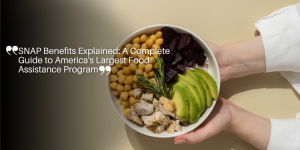Complete Guide: How to Apply for SNAP Benefits (Food Stamps)
Understanding SNAP Benefits
Overview of the Supplemental Nutrition Assistance Program (SNAP) and Its Evolution from Food Stamps
Once known as the food stamps program, SNAP (Supplemental Nutrition Assistance Program) was established to provide low-income individuals and families with the means to purchase food.
Originally, the program required beneficiaries to physically handle stamps to buy food.
Over time, it has evolved significantly to become more efficient and user-friendly, ensuring that needy households receive essential nutritional support.
How SNAP Helps Low-Income Individuals and Families Purchase Food
SNAP is designed to supplement the food budget of low-income households, so they can afford to buy more of the nutritious food they need.
Each month, SNAP distributes benefits directly to eligible beneficiaries’ Electronic Benefits Transfer (EBT) card, allowing them to purchase food items at authorized retail stores and farmers’ markets.
This immediate assistance improves food security and well-being for millions of individuals and families, enabling them to focus on other expenses and financial issues they might face.
Basic Introduction to the Electronic Benefits Transfer (EBT) Card System
The Electronic Benefits Transfer (EBT) card system is a modern, secure way for SNAP beneficiaries to access their benefits.
Once approved for SNAP, individuals are issued an EBT card, which works similarly to a debit card.
Each month, funds are electronically loaded onto the card, which can then be used to buy food at various approved stores.
This system reduces the stigma associated with using food stamps and ensures a seamless transaction process for both the beneficiary and the retailer.
Understanding how SNAP functions and how to effectively use the EBT card system are crucial steps for those needing this assistance.
Becoming familiar with these components of SNAP helps in managing benefits efficiently and maximizing the support provided.
 Every month the card is recharged
Every month the card is recharged
SNAP Eligibility Requirements
State-Specific Income Limits
One of the primary criteria for SNAP eligibility is your income, which must fall under the limit set by your state.
States have different income thresholds tailored to various household sizes and compositions.
Typically, these limits are based on a percentage of the federal poverty level.
For example, a single individual might have to make less than 130% of the federal poverty level to qualify.
It’s essential to check your state’s specific guidelines to understand where your income stands.
Role of Additional Resources
When determining eligibility, states don’t just look at income; they also consider your resources.
These resources can include:
- 🍗 Money in bank accounts
- 🍗 Investments
- 🍗 Property other than your home
Each state has different allowances for the amount of resources you can possess while still qualifying for SNAP.
It’s advisable to familiarize yourself with these resource limits as they vary significantly from state to state.
Key Factors in Evaluating Applications
States evaluate applications based on a combination of factors:
- 🍗 Income and Resources: As previously mentioned, both play a crucial role.
- 🍗 Household Size and Composition: States consider who shares your housing and food expenses.
- 🍗 Employment Status: Your work situation and if you are actively seeking employment.
- 🍗 Categorical Eligibility: Sometimes, participation in other assistance programs may render you automatically eligible.
Being aware of these factors can help you better prepare your application and understand your eligibility status.
By thoroughly understanding these criteria, you can better navigate the application process and determine your chances of benefitting from SNAP.
Next, you’ll learn more about the application process and what you need to apply.
Application Process
Applying for SNAP benefits, or food stamps, involves several steps.
This chapter will guide you through the different methods of application, the necessary documentation, and what to expect during your mandatory interview.
Different Methods to Submit Applications
Depending on your state, you have several options to submit your application for SNAP benefits:
- 🍗 Online: Most states offer an online application process. This is typically the easiest and fastest method. Simply visit your state or local SNAP office’s website to start your application.
- 🍗 From State Offices In-Person: You can visit a local SNAP office to fill out and submit your application in person. This can be helpful if you have questions or need assistance with the application process.
- 🍗 By Mail: In some cases, you can request an application to be sent to you via mail. Complete the application and mail it back to your local SNAP office.
- 🍗 By Fax: If available, you may also fax your completed application to your local SNAP office.
Required Documentation and Information
To apply for SNAP benefits, you will need to provide specific documentation and information, including:
- 🍗 Proof of identity (e.g., driver’s license, state ID card)
- 🍗 Social Security numbers for all household members applying for benefits
- 🍗Proof of income (e.g., pay stubs, tax returns)
- 🍗 Proof of address (e.g., utility bills, lease agreements)
- 🍗 Information about household expenses (e.g., rent, utilities, child care costs)
- 🍗 Details about assets or resources (e.g., bank statements)
Ensuring you have all the necessary documentation ready can help expedite the application process.
What to Expect During the Mandatory Interview Process
After you submit your application, you may need to participate in a mandatory interview.
This interview is typically conducted by phone but can also be in person if needed.
During the interview, a SNAP representative will:
- 🍗 Verify the information provided in your application
- 🍗 Discuss your household’s financial situation, including any income and expenses
- 🍗 Explain the SNAP program, including benefit amounts and how to use your EBT card
It’s important to be prepared and provide accurate information during your interview to ensure your application is processed smoothly.
Understanding these steps and having the required documentation ready can help simplify the SNAP application process.
This proactive approach will assist in making the experience as stress-free as possible.
Next, you’ll learn how to use the EBT card effectively to maximize your benefits.
Using Your EBT Card
How Monthly Benefits Are Loaded onto Your EBT Card
Each month, your SNAP benefits are automatically added to your Electronic Benefits Transfer (EBT) card. This reload occurs on a specific date, which varies by state.
You can continue using your EBT card at authorized retailers once the new benefits are loaded into your account.
Where and How to Use Your SNAP Benefits
You can use your EBT card at most grocery stores, supermarkets, and even some farmers’ markets that accept SNAP benefits.
Simply swipe your card at the register and enter your PIN.
Be mindful that SNAP benefits can only be used for eligible food items and cannot be used for non-food items such as alcohol, tobacco, and household supplies.
Tips for Managing Your Benefits Effectively
Managing your SNAP benefits wisely is essential to ensure you have sufficient resources throughout the month:
- 🍗 Budget Wisely: Plan your meals and make a shopping list. This helps avoid unnecessary purchases.
- 🍗 Take Advantage of Sales and Discounts: Look for promotions and use coupons to maximize your benefits.
- 🍗 Monitor Your Balance Regularly: Keep track of your remaining benefits through store receipts or state-specific mobile apps.
- 🍗 Shop at Authorized Retailers: Ensure you are shopping at places that accept EBT cards to make the most out of your benefits.
With these steps, you can make your SNAP benefits last longer and meet your nutritional needs efficiently.
Checking Your SNAP Balance
How to Check Your Balance Through Store Receipts
One of the simplest ways to keep track of your SNAP benefits is through store receipts.
After making a purchase using your EBT card, many stores will print your remaining balance at the bottom of your receipt.
This method is convenient and gives you an immediate update on your current balance.
Using State-Specific Mobile Apps for Balance Monitoring
Many states offer mobile apps specifically designed to help SNAP beneficiaries manage their benefits.
These apps are a great tool for checking your balance on the go.
Simply download your state’s app, log in with your details, and you can quickly see how much you have left.
Additionally, these apps may offer other useful features, such as transaction histories and benefit schedules.
Other Methods to Track Your Remaining Benefits
For those who prefer other methods, there are several additional ways to monitor your SNAP balance:
- 🍗 Automated Phone Systems: Many states have automated phone systems where you can call and get your balance by entering your EBT card number.
- 🍗 Online Portals: States often provide online portals accessible from their official SNAP websites. After logging in, you can view detailed information about your benefits.
- 🍗 EBT Customer Service: If you’re having trouble with other methods, you can always call the customer service number on the back of your EBT card for assistance.
By regularly checking your balance, you ensure that you can manage and allocate your benefits effectively.
This way, you can make informed shopping decisions and take full advantage of any sales or discounts you encounter.
Additional Resources and Support
Where to Find Help with the Application Process
Navigating the SNAP application process can feel overwhelming, but don’t worry—there are plenty of resources available to help you.
Local community organizations, such as food banks and social service agencies, often offer assistance with completing your SNAP application.
These organizations can provide guidance, answer your questions, and ensure that your application is filled out correctly.
You can also find online resources, including tutorials and guides on your state’s SNAP website.
These resources often include detailed step-by-step instructions, FAQs, and even video walkthroughs that can make the application process easier to understand.
How to Contact Your Local SNAP Office
If you need personalized assistance, contacting your local SNAP office is a great option.
Each state has its own SNAP office, and many counties or cities have local offices dedicated to helping residents apply for and manage their SNAP benefits.
To find your local SNAP office, you can visit your state’s SNAP website or the USDA’s.
This directory will help you find the contact information for your nearest SNAP office, including addresses, phone numbers, and office hours.
Don’t hesitate to reach out to them if you have any questions or need help with your application.
Useful Tools and Resources for SNAP Beneficiaries
Once you are approved for SNAP benefits, there are several tools and resources that can help you manage your benefits effectively:
- 🍗 State-specific mobile apps: Many states offer mobile apps that allow you to check your EBT balance, monitor your transaction history, and find nearby participating retailers.
- 🍗 EBT customer service: The contact number on the back of your EBT card can connect you to customer service for any issues or questions about your card.
- 🍗 Online portals: Some states provide online portals where you can log in to view your benefits, update your information, and manage your account.
- 🍗 Shopping guides: Various online resources provide tips on how to budget your SNAP benefits, meal planning, and recipes that make the most of your SNAP dollars.
By leveraging these additional resources and support, you can navigate the SNAP program more effectively and ensure you are making the most of your benefits for yourself and your family.







